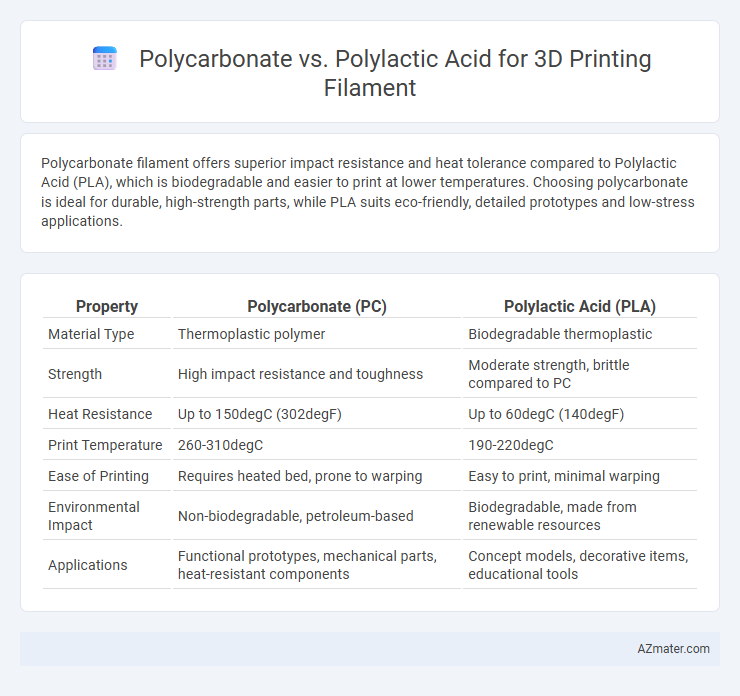Polycarbonate filament offers superior impact resistance and heat tolerance compared to Polylactic Acid (PLA), which is biodegradable and easier to print at lower temperatures. Choosing polycarbonate is ideal for durable, high-strength parts, while PLA suits eco-friendly, detailed prototypes and low-stress applications.
Table of Comparison
| Property | Polycarbonate (PC) | Polylactic Acid (PLA) |
|---|---|---|
| Material Type | Thermoplastic polymer | Biodegradable thermoplastic |
| Strength | High impact resistance and toughness | Moderate strength, brittle compared to PC |
| Heat Resistance | Up to 150degC (302degF) | Up to 60degC (140degF) |
| Print Temperature | 260-310degC | 190-220degC |
| Ease of Printing | Requires heated bed, prone to warping | Easy to print, minimal warping |
| Environmental Impact | Non-biodegradable, petroleum-based | Biodegradable, made from renewable resources |
| Applications | Functional prototypes, mechanical parts, heat-resistant components | Concept models, decorative items, educational tools |
Introduction to Polycarbonate and Polylactic Acid Filaments
Polycarbonate (PC) filament is known for its high impact resistance, heat tolerance up to 110degC, and excellent mechanical strength, making it ideal for durable, functional 3D prints. Polylactic Acid (PLA) filament, derived from renewable resources like corn starch, offers ease of printing, low warping, and biodegradability, suited for detailed prototypes and eco-friendly projects. Both filaments serve distinct purposes in 3D printing, with PC favored for strength-intensive applications and PLA preferred for user-friendly, environmentally-conscious prints.
Material Properties: Polycarbonate vs Polylactic Acid
Polycarbonate (PC) exhibits superior impact resistance, heat resistance up to 150degC, and high tensile strength around 60 MPa, making it ideal for durable and functional 3D prints. Polylactic Acid (PLA) is biodegradable, derived from renewable resources, with lower heat resistance near 60degC and tensile strength around 60 MPa but offers easier printability and reduced warping. PC's toughness and thermal endurance surpass PLA's, which favors eco-friendly applications with less demanding mechanical requirements.
Strength and Durability Comparison
Polycarbonate filament exhibits superior strength and impact resistance compared to polylactic acid, making it ideal for applications requiring high mechanical performance and durability. Polylactic acid, while easier to print and biodegradable, lacks the toughness and heat resistance of polycarbonate, leading to less durable finished parts under stress. For 3D printing projects demanding long-lasting, robust components, polycarbonate offers enhanced longevity and structural integrity.
Printability and User Experience
Polycarbonate (PC) filament offers high durability and heat resistance, making it ideal for engineering prototypes but requires a high printing temperature (above 260degC) and a heated bed to prevent warping, presenting challenges for novice users. Polylactic Acid (PLA) filament, made from renewable resources, is favored for its ease of printability at lower temperatures (around 190-220degC), minimal warping, and excellent surface finish, enhancing user experience especially for beginners and hobbyists. While PC demands precise environmental controls and an enclosed print chamber, PLA's forgiving nature and biodegradability make it a preferred choice for general-purpose 3D printing.
Thermal Resistance and Stability
Polycarbonate (PC) offers exceptional thermal resistance with a heat deflection temperature around 110-130degC, making it ideal for parts exposed to high temperatures or mechanical stress. Polylactic Acid (PLA), derived from renewable resources, typically withstands temperatures only up to 60degC before deforming, limiting its use in heat-intensive applications. PC provides superior dimensional stability and durability under thermal stress compared to PLA, which tends to warp and lose mechanical integrity quickly when exposed to elevated temperatures.
Surface Finish and Aesthetic Qualities
Polycarbonate filament offers a smooth, glossy surface finish with high impact resistance and clarity, making it ideal for parts requiring durability and a polished look. Polylactic Acid (PLA) provides a matte to semi-glossy finish with vibrant color options and greater ease of printing, favored for detailed aesthetic models and prototypes. The choice depends on whether superior strength and gloss or color variety and printability are prioritized for the final 3D print appearance.
Environmental Impact and Sustainability
Polycarbonate (PC) filament offers exceptional durability and heat resistance but is derived from non-renewable petroleum resources, contributing to higher carbon emissions and environmental impact during production. Polylactic Acid (PLA) filament, made from renewable plant-based materials such as corn starch, is biodegradable and compostable under industrial conditions, significantly reducing ecological footprint and promoting sustainability for 3D printing applications. Despite PLA's lower thermal and mechanical performance compared to PC, its eco-friendly lifecycle makes it a preferable choice for environmentally conscious 3D printing projects.
Cost Analysis: Polycarbonate vs PLA Filament
Polycarbonate filament for 3D printing generally costs between $40 to $70 per kilogram, reflecting its high strength, heat resistance, and durability, making it suitable for engineering applications. Polylactic Acid (PLA) filament is significantly more affordable, typically priced around $20 to $30 per kilogram, favored for ease of use and eco-friendliness but with lower thermal and mechanical properties. The cost difference highlights PLA as the economical choice for prototyping and hobbyist projects, while polycarbonate is preferred for functional parts requiring enhanced performance and longevity.
Ideal Applications for Each Filament
Polycarbonate filament is ideal for manufacturing durable, high-strength parts requiring impact resistance and thermal stability, such as automotive components, protective gear, and mechanical prototypes. Polylactic Acid (PLA) excels in producing detailed, biodegradable models suited for educational tools, decorative items, and rapid prototyping where ease of printing and environmental sustainability are prioritized. Choosing between polycarbonate and PLA depends on the specific application demands for strength, heat resistance, and eco-friendliness in 3D printing projects.
Choosing the Right Filament for Your 3D Printing Needs
Polycarbonate (PC) filament offers exceptional strength, heat resistance up to 110degC, and durability, making it ideal for functional prototypes and engineering parts requiring high impact resistance. Polylactic Acid (PLA) is a biodegradable, easy-to-print filament with low warping and a lower melting temperature around 180-220degC, perfect for beginners and models prioritizing environmental sustainability and detail. Selecting the right filament depends on the specific application needs: choose PC for mechanical strength and thermal stability, while PLA suits rapid prototyping with minimal post-processing.

Infographic: Polycarbonate vs Polylactic Acid for 3D Printing Filament
 azmater.com
azmater.com